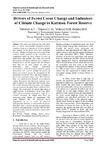Drivers of Forest Cover Change and Indicators of Climate Change in Katimok Forest Reserve

View/
Date
2016Author
Jebiwott, Alice
Ogendi, G. M
Makindi, Stanley Maingi
Esilaba, Moses
Metadata
Show full item recordAbstract
The conversion of forests into other land
uses as well as unsustainable utilization of forest
resources leads to a reduction in the area, quality
and quantity of the forest cover and ecosystem
services. Changes in forest cover as a result of the
resource strain imposed on the ecosystem can
significantly affect the local climate in terms of
temperature and rainfall. This study was carried
out to assess the drivers of forest cover change in
Katimok forest and the impacts that the changes
have had on the local climate in terms of
temperature and rainfall. Household
questionnaires, field observations and focus group
discussions were used to identify the drivers of
forest cover and to assess the perceptions of the
community on whether there had been changes in
forest cover and local climate since 1985. Climatic
data was obtained from Katimok meteorological
station. Descriptive and inferential statistics were
used to analyze the social data and climatic data.
The results indicated that agriculture and logging
were perceived as the major drivers of forest cover
change. The results from the climate data shows a
slight increase in temperature trend from 1985-
2012 with mean annual temperature range of +-
1.44561. Similarly, the rainfall data shows an
increasing trend, though not significantly. The
study indicates that the observed forest
degradation is as a result of observed
anthropogenic activities in and around the forest.
Therefore, there is need to develop stringent policy
measures and appropriate strategies that can alter
this unfavorable situation and lead to conservation
of this ecosystem.
